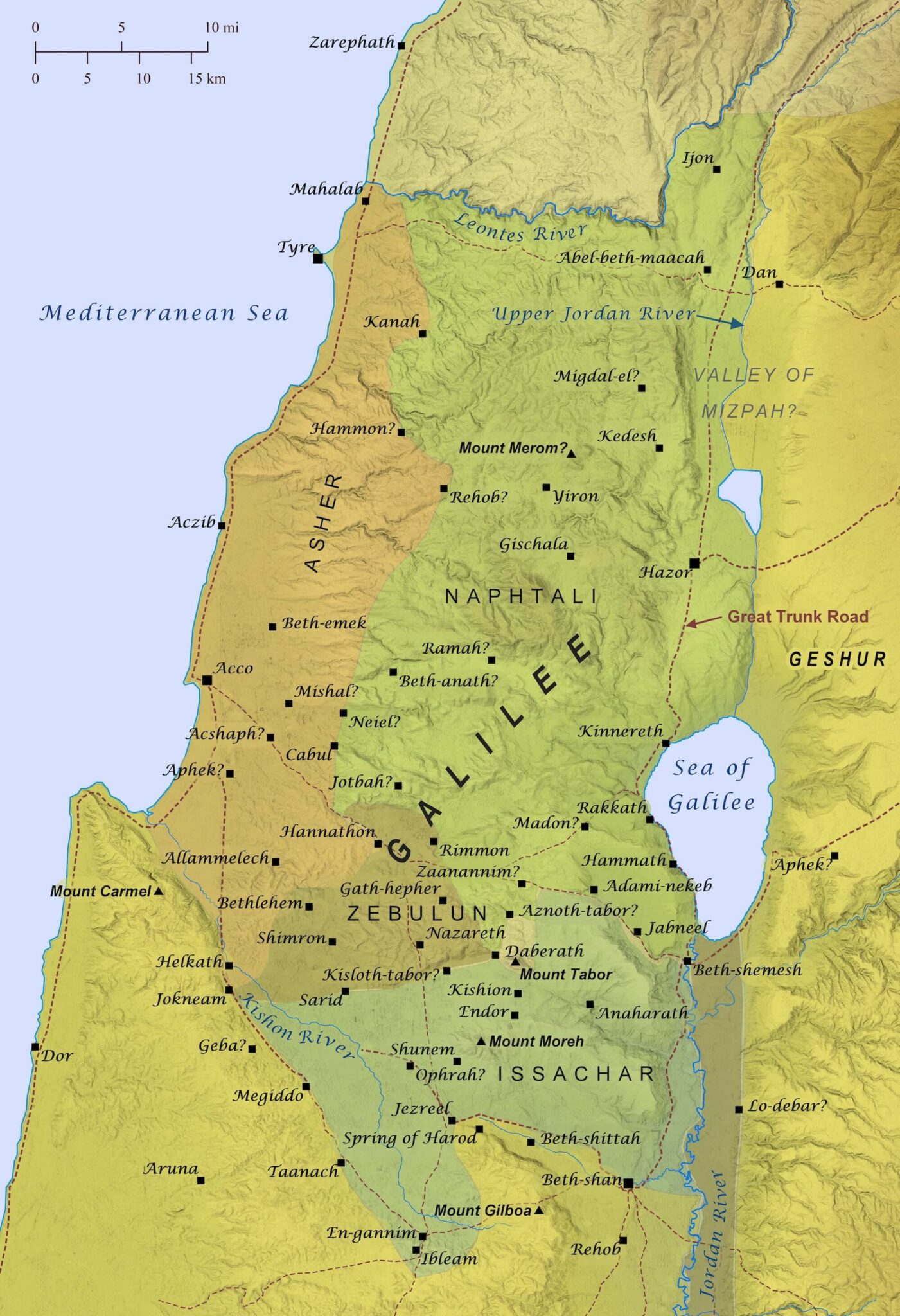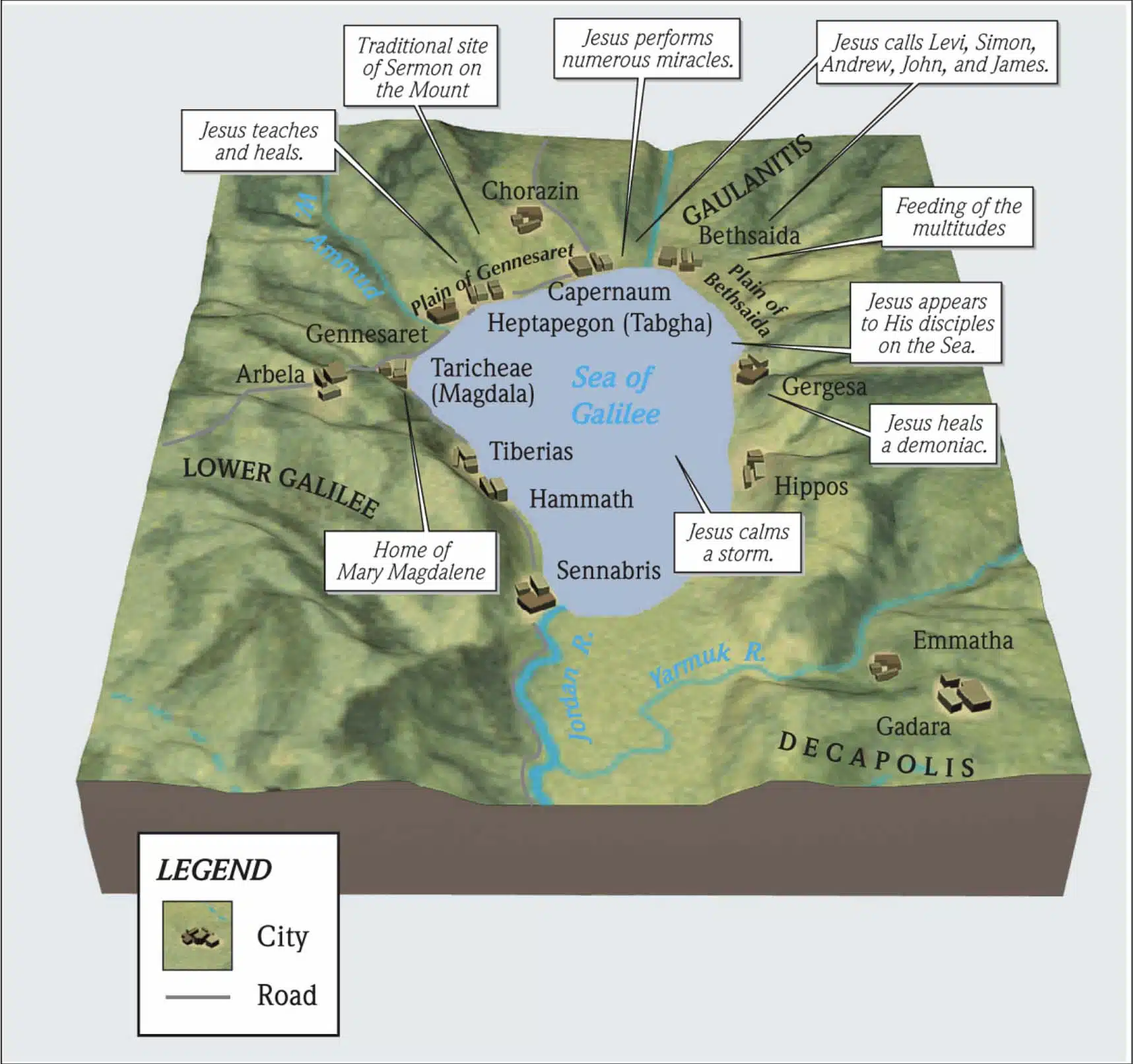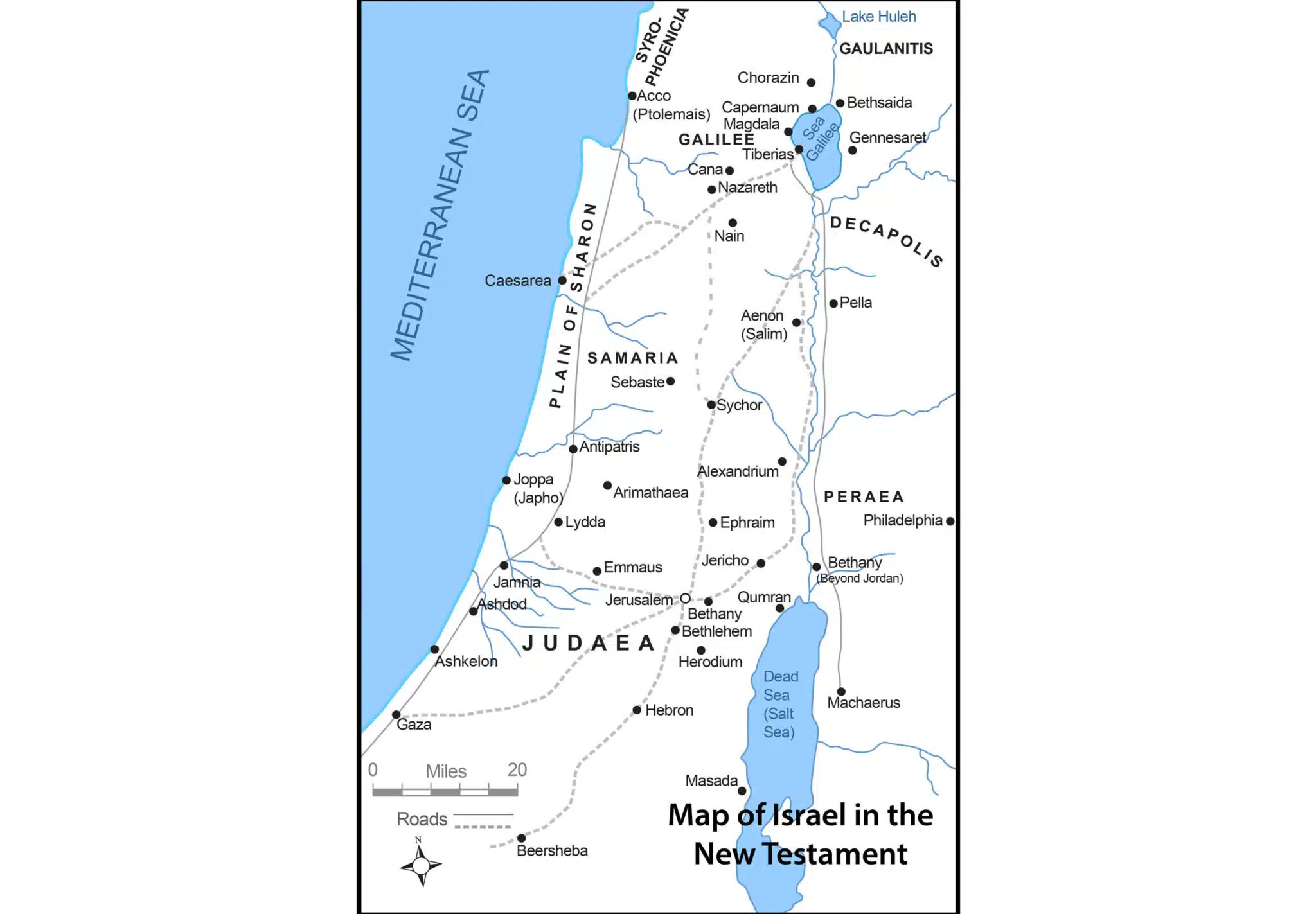To temporarily avoid trouble with the religious leaders of Jerusalem, Jesus moves to Capernaum north of Galilee to begin His ministry. Matthew notes this fulfills yet another prophecy from Isaiah.
The parallel accounts of these events are found in Mark 1:14, Luke 3:20 and Luke 2:32.
Matthew signals a break in the narrative—Now when. This phrase indicates that what happened next occurred sometime after Jesus’s temptation by the devil in the wilderness and His being ministered to by angels.
What happened were these events:
- Jesus heard that John (the Baptizer) had been taken into custody (v 12).
- Jesus left the city of Nazareth (v 13).
- Jesus came and settled in Capernaum which is by the Sea of Galilee (v 13).
The text is ambiguous about the sequence of these events.
There are two likely possibilities as to their order.
One possibility could be that first, Jesus heard that John was arrested. Then He withdrew to the Roman District of Galilee and to His hometown of Nazareth which was located in that district. Then He departed Nazareth and came to and settled in the city of Capernaum which is near the shore of the Sea of Galilee (v 13).
A second possible sequence could be that Jesus first returned to His hometown of Nazareth. And it was while He was in Nazareth when He heard that John had been taken into custody (v 12). Then He withdrew towards the Sea of Galilee. And He came and settled in Capernaum which is by the sea (v 13).
These events could have occurred in either order.
Matthew does not tell us who arrested John, only that as a result of John’s imprisonment, Jesus withdrew into Galilee.
It appears that John the Baptist was arrested twice. We are not told which arrest is being referred to. Matthew and Mark say that John was taken into custody during Jesus’s forty days in the wilderness, while the Gospel writer John says that the Baptizer was arrested sometime later after Jesus’s ministry was in full swing, sometime after Jesus’s secret meeting with Nicodemus. At that time Jesus began baptizing people in Judea while John was baptizing people in Aenon near Salim (John 3:22-23). (Aenon and Salim are located on the Jordan River approximately fifty miles north of the Dead Sea and forty miles south of Galilee).
The first time John was arrested was likely by the religious leaders who did not like being called a “brood of vipers” by John (Matthew 3:7). These religious leaders probably took John into custody, interrogated him, and then let him go, a pattern observed in other biblical stories. John for his part moved further north out of Judea (and closer to Herod Antipas’s jurisdiction in Galilee) where he continued to preach repentance and of God’s coming kingdom. John the Baptizer would later be arrested a second time, this time by Herod Antipas who would reluctantly have him executed. Given that Matthew is describing Jesus’ initial choice for a ministry headquarters, it seems more likely he is referring to John’s first arrest.
Because of John’s arrest, Jesus conducts His early ministry away from the Sadducees’ lion’s den of Judea. Jesus came and settled in Capernaum, a small fishing village on the northern shoreline by the sea (of Galilee) (v 13). This region is in ancient tribal lands of Zebulun and Naphtali among the northern borders of Israel.
Matthew then includes his eighth overall Old Testament scripture and offers his seventh instance of a directly fulfilled Messianic prophecy.
The quote comes from Isaiah 9:1-2.
“But there will be no more gloom for her who was in anguish; in earlier times He treated the land of Zebulun and the land of Naphtali with contempt, but later on He shall make it glorious, by the way of the sea, on the other side of Jordan, Galilee of the Gentiles.
The people who walk in darkness
Will see a great light;
Those who live in a dark land,
The light will shine on them.”
Isaiah’s prophecy was given to the Kingdom of Judah, foretelling the Assyrian invasion of Israel and Judah from the north. The border regions of Zebulun and Naphtali would take the brunt of this invading force. The “gloom,” “anguish,” “contempt,” and “darkness” from this invasion was fulfilled within the prophet’s lifetime. But the “later on” dawning glory and great light is the future presence of the Messiah who would begin and base His ministry in these same regions.
Matthew’s citation slightly modifies the Isaiah text. The land of Zebulun and the land of Naphtali refer to the territory around Galilee (v 13). Zebulun and Naphtali are two of the twelve tribes of Israel, and had specific borders appointed during the time of Joshua (Joshua 19:10-16, 32-39). By the way of the sea, beyond the Jordan, Galilee echoes this reference (v 15). Beyond the Jordan here more implies “above” or “north” of the Jordan rather than our more common usage which means “across.” The phrase of the Gentiles is added to signal the occupying invaders. The people who were sitting in darkness refers to those living in or from that invaded region (v 16). The Messiah’s public ministry in this region is captured by the fact that they saw a great Light. This theme is repeated: And those who were sitting in the land and shadow of death, Upon them a Light dawned (v 16). An extra nuance is added by Upon them a Light dawned (v 16). The use of dawned hints that the Messiah’s public ministry will begin here. The town where Matthew tells us that Jesus begins his public ministry is Capernaum. It was a Jewish fishing village located in the Galilee region Isaiah foretold seven centuries earlier.
Biblical Text
12 Now when Jesus heard that John had been taken into custody, He withdrew into Galilee; 13 and leaving Nazareth, He came and settled in Capernaum, which is by the sea, in the region of Zebulun and Naphtali. 14 This was to fulfill what was spoken through Isaiah the prophet:
15 “The land of Zebulun and the land of Naphtali,
By the way of the sea, beyond the Jordan, Galilee of the Gentiles—
16 “The people who were sitting in darkness saw a great Light,
And those who were sitting in the land and shadow of death,
Upon them a Light dawned.”
Check out our other commentaries:
-
Hebrews 11:32-34 meaning
The Pauline Author recognizes that he cannot acknowledge all of the faithful believers, but he names some of the incredible trials they endured for their...... -
Proverbs 9:4-6 meaning
Wisdom calls out to the naïve and the fools, inviting them to the table she has prepared....... -
1 Thessalonians 2:13-18 meaning
Paul tells the Thessalonians that they are suffering just as other believers do elsewhere, under persecution from people who oppose God. Paul misses the Thessalonians...... -
Deuteronomy 11:1-7 meaning
Moses commands the Israelites to love their Suzerain God for who He is and what He has done....... -
Deuteronomy 13:1-5 meaning
To enforce the second of the Ten Commandments, Moses commands the Israelites to execute any false prophet who may entice them to serve other gods,......





